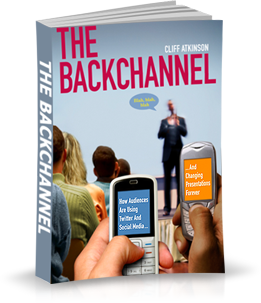In a powerful post on her blog, Danah Boyd describes blow-by-blow how it felt to be a speaker when the backchannel turned against her at a recent conference.

Danah Boyd on stage at Web 2.0 Expo NY 2009. Photo by James Duncan Davidson http://is.gd/52WJL
As she reflects on the backchannel and its impact on her talk, she writes, “if that’s what public speaking is going to be like, I’m out,” and “I can’t take the idea that this is the future.”
It would be a travesty if we lost committed and passionate public speakers because of the changes that the backchannel is bringing to bear on live presentations.
Audiences are certainly accountable for what they say and do, and there are techniques a presenter can use to make sure they are, for example:
- Acknowledging their presence by including your Twitter credentials and meeting hashtag on your title slide and welcoming them verbally.
- Inviting a colleague to be a moderator to bring to your attention if the mood of the audience turns against you.
- Taking occasional Twitter breaks to address questions and take the temperature of the audience.
But the burden of engaging the new world of the backchannel, and making experiences positive and productive, rests squarely on the shoulders of hosts and presenters.
Hosts have to be responsible and accountable for creating an environment that is physically comfortable for speakers and audiences, and that removes distractions for everyone. In this case, the host should have made sure Danah was comfortable with the speaking environment, and provided her with the podium she wanted and lighting that did not blind her. A host should never display a backchannel onstage without a presenter’s consent.
But it is presenters today who most have to understand the seismic changes the backchannel is introducing to presentations, and to learn how to deal with them. The day of the lecture format is over – presenters simply need to use social media and other tools to hold a conversation with an audience before, during, and after a presentation.
This case offers the opportunity for discussion of the need for new perspectives and techniques that presenters need today, including:
- Flexiblity
- Improvisation
- Facilitation
For example, in her e-Book about presenting with Twitter, presentation coach Olivia Mitchell suggests (pp. 31-32) that in a situation like the one Danah faced, a presenter would plan to be aware of what the backchannel was saying (via a moderator or Twitter breaks), and when she was aware of negativity she could:
- Summarize the gist of the dissatisfied tweets.
- Ask the audience as a whole to respond by show of hands whether this is a problem for them too.
- If there are a significant number (30% upwards) who indicate they’re dissatisfied, facilitate a discussion to find out what the audience would like from you.
- Ask people to form pairs or small groups and to discuss what they would like you to address (this works well because people have a chance to discuss their ideas in a small group before calling out in the large group).
- Gather the items on a flipchart or whiteboard (do not number them at this stage).
- Chunk similar items together (you can do this by marking similar items with a coloured pen or a letter).
- List the order in which you will address the items.
- Start addressing the first item in the list.
Of course there are limits on what you can do within the constraints of a 20-minute talk, and following all of these steps might take up more time than you would like to spend on it.
But this approach conveys a particular spirit that presenters will need in order to engage the backchannel, namely:
- Hey, I’m not perfect, and it takes a lot for me to be standing up here.
- It’s a privilege to speak to you, and I’ll work hard to help you learn something new and create an enjoyable experience.
- If I missed the mark, let’s talk about it so we don’t waste one another’s time. I’ve put some forethought into the possibility this might happen, and am willing to change course to the best of my ability.
- If you’re still unhappy, and most other people in the audience are happy, please feel free to leave and attend another presentation where there is a better fit.
The backchannel is not something to fear, and it’s no reason for talented people to curtail their speaking engagements. It’s simply a new world out there. Nobody has all the answers to the questions the backchannel presents, but through trial and error – and sometimes painful experiences – we’ll figure out a way forward together.






It would also help if presenters weren't expected to cover, say, four hours' worth of material in one hour. Narrow the scope, and you get deeper knowledge sharing.
Great point, Gia – that’s one of the main shifts we have to make in this new world of presenting – to make fewer, more important points and to leave more time and space for conversation so those points sink in…